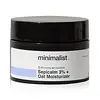What's inside
What's inside
 Key Ingredients
Key Ingredients

 Benefits
Benefits

 Concerns
Concerns

 Ingredients Side-by-side
Ingredients Side-by-side

Water
Skin ConditioningAvena Sativa Kernel Extract
AbrasiveSqualane
EmollientGlycerin
HumectantXylitylglucoside
HumectantAnhydroxylitol
HumectantXylitol
HumectantSodium Cocoyl Amino Acids
CleansingSarcosine
Skin ConditioningPotassium Aspartate
Skin ConditioningMagnesium Aspartate
Skin ConditioningCaprylic/Capric Triglyceride
MaskingPanthenol
Skin ConditioningPentylene Glycol
Skin ConditioningAvena Sativa Kernel Flour
AbrasiveSodium Polyglutamate
HumectantUndecane
EmollientButyrospermum Parkii Butter
Skin ConditioningTocopheryl Acetate
AntioxidantArginine
MaskingGlycine
BufferingAlanine
MaskingHistidine
HumectantSodium Lactate
BufferingArachidyl Alcohol
EmollientBehenyl Alcohol
EmollientArachidyl Glucoside
EmulsifyingTridecane
PerfumingAluminum Starch Octenylsuccinate
AbsorbentTrehalose
HumectantPolyacrylate Crosspolymer-6
Emulsion StabilisingPhenoxyethanol
PreservativeEthylhexylglycerin
Skin ConditioningCitric Acid
BufferingTrisodium Ethylenediamine Disuccinate
Water, Avena Sativa Kernel Extract, Squalane, Glycerin, Xylitylglucoside, Anhydroxylitol, Xylitol, Sodium Cocoyl Amino Acids, Sarcosine, Potassium Aspartate, Magnesium Aspartate, Caprylic/Capric Triglyceride, Panthenol, Pentylene Glycol, Avena Sativa Kernel Flour, Sodium Polyglutamate, Undecane, Butyrospermum Parkii Butter, Tocopheryl Acetate, Arginine, Glycine, Alanine, Histidine, Sodium Lactate, Arachidyl Alcohol, Behenyl Alcohol, Arachidyl Glucoside, Tridecane, Aluminum Starch Octenylsuccinate, Trehalose, Polyacrylate Crosspolymer-6, Phenoxyethanol, Ethylhexylglycerin, Citric Acid, Trisodium Ethylenediamine Disuccinate
Water
Skin ConditioningGlycerin
HumectantCaprylic/Capric Triglyceride
MaskingNiacinamide
SmoothingCetearyl Alcohol
EmollientDimethicone
EmollientPhenoxyethanol
PreservativeCeteareth-20
CleansingBehentrimonium Methosulfate
Caprylyl Glycol
EmollientPolyglyceryl-3 Diisostearate
EmulsifyingSodium Lauroyl Lactylate
EmulsifyingPotassium Phosphate
BufferingDisodium EDTA
Dipotassium Phosphate
BufferingCeramide NP
Skin ConditioningCeramide AP
Skin ConditioningPhytosphingosine
Skin ConditioningCholesterol
EmollientXanthan Gum
EmulsifyingCarbomer
Emulsion StabilisingEthylhexylglycerin
Skin ConditioningSodium Hyaluronate
HumectantCeramide EOP
Skin ConditioningWater, Glycerin, Caprylic/Capric Triglyceride, Niacinamide, Cetearyl Alcohol, Dimethicone, Phenoxyethanol, Ceteareth-20, Behentrimonium Methosulfate, Caprylyl Glycol, Polyglyceryl-3 Diisostearate, Sodium Lauroyl Lactylate, Potassium Phosphate, Disodium EDTA, Dipotassium Phosphate, Ceramide NP, Ceramide AP, Phytosphingosine, Cholesterol, Xanthan Gum, Carbomer, Ethylhexylglycerin, Sodium Hyaluronate, Ceramide EOP
 Reviews
Reviews

Ingredients Explained
These ingredients are found in both products.
Ingredients higher up in an ingredient list are typically present in a larger amount.
This ingredient is an emollient, solvent, and texture enhancer. It is considered a skin-softener by helping the skin prevent moisture loss.
It helps thicken a product's formula and makes it easier to spread by dissolving clumping compounds.
Caprylic Triglyceride is made by combining glycerin with coconut oil, forming a clear liquid.
While there is an assumption Caprylic Triglyceride can clog pores due to it being derived from coconut oil, there is no research supporting this.
Learn more about Caprylic/Capric TriglycerideEthylhexylglycerin (we can't pronounce this either) is commonly used as a preservative and skin softener. It is derived from glyceryl.
You might see Ethylhexylglycerin often paired with other preservatives such as phenoxyethanol. Ethylhexylglycerin has been found to increase the effectiveness of these other preservatives.
Glycerin is already naturally found in your skin. It helps moisturize and protect your skin.
A study from 2016 found glycerin to be more effective as a humectant than AHAs and hyaluronic acid.
As a humectant, it helps the skin stay hydrated by pulling moisture to your skin. The low molecular weight of glycerin allows it to pull moisture into the deeper layers of your skin.
Hydrated skin improves your skin barrier; Your skin barrier helps protect against irritants and bacteria.
Glycerin has also been found to have antimicrobial and antiviral properties. Due to these properties, glycerin is often used in wound and burn treatments.
In cosmetics, glycerin is usually derived from plants such as soybean or palm. However, it can also be sourced from animals, such as tallow or animal fat.
This ingredient is organic, colorless, odorless, and non-toxic.
Glycerin is the name for this ingredient in American English. British English uses Glycerol/Glycerine.
Learn more about GlycerinPhenoxyethanol is a preservative that has germicide, antimicrobial, and aromatic properties. Studies show that phenoxyethanol can prevent microbial growth. By itself, it has a scent that is similar to that of a rose.
It's often used in formulations along with Caprylyl Glycol to preserve the shelf life of products.
Water. It's the most common cosmetic ingredient of all. You'll usually see it at the top of ingredient lists, meaning that it makes up the largest part of the product.
So why is it so popular? Water most often acts as a solvent - this means that it helps dissolve other ingredients into the formulation.
You'll also recognize water as that liquid we all need to stay alive. If you see this, drink a glass of water. Stay hydrated!
Learn more about Water